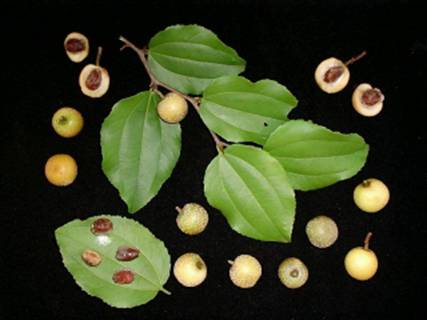ZIZIPHUS JOAZEIRO
POPULAR NAMES: Joá, Juá, laranja de vaqueiro, cowboy orange.
RHAMNACEAE

INDIGENOUS NAME: Joá comes from the Tupi and means "yellow fruit."
Origin: Occurs in the caatinga of northeast region, in floodplains of the Rio San Francisco in the north of Minas Gerais and mainly within the Bahia, Brazil.
Characteristics:
Medium-sized tree, grows to
Planted in the site of Frutas Raras: February 2002, blossomed in 2004, and bear fruit in 2005.
Tips for cultivation: Fast growing tree that resists low temperatures (to -4°C (25°F)), and grows at any altitude. The soil may be deep, moist, acid pH, formation of sand or clay (red soil) and even gritty. The tree is a pioneer and great for use in reforestation.
Planting:
Round seed, cream in
color, has hard shell and keep the germinative power for up to 1 year.
Germinate in
Propagation:
Can be planted in full
sun and in forests and in reforestation of permanent preservation.
Space of 8 x
Cultivating:
Make only forming pruning of the crown and remove branches that were
appeared
at the base of the trunk and branches that are very intertwined, and perhaps
prevent the formation of the crown.
Fertilize with
organic compost, can be (
Uses: The fruits look like small yellow apples, taste is sweet and strong that resembles a mixture of peanut and orange. Can be consumed in natura or used to make liquor and sweets.
Flowering in the site of Frutas Raras: November to January.
Fruiting in the site of Frutas Raras: May to July.
BUY THE BOOK “COLECIONANDO FRUTAS”
Back to the seedlist (English) or back to Rhamnaceae (Portuguese)